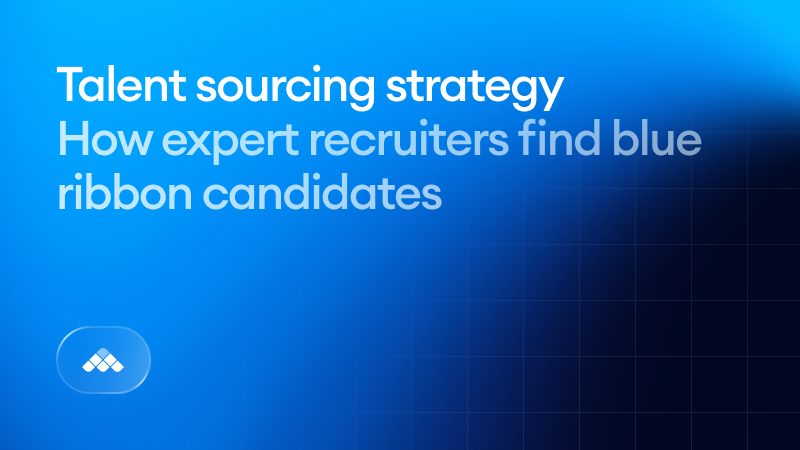Behind every great hire is a great sourcing strategy: one built on foresight, relationships, and data. The most effective talent teams obsessively anticipate future needs, nurture relationships, and ensure great talent is always within reach.
Still, many organizations rely on outdated, transactional methods, scrambling to fill roles instead of cultivating long-term talent pipelines. And that’s simply a losing game.
This guide breaks down what sourcing really means, why it’s the backbone of modern recruiting, and how to build a repeatable, data-driven sourcing strategy that helps you find the best candidates, faster.
3 key takeaways
- A strong talent sourcing strategy ensures you’re never starting from zero when new roles open.
- Great sourcing combines human relationship-building with automation, data, and AI insights.
- Recruiters who master sourcing strategy move from reactive hiring to long-term talent advantage.
What is sourcing?
Sourcing is the process of identifying, engaging, and nurturing potential candidates, often before they apply or before roles even exist. It includes everything from searching databases and social networks to maintaining talent communities and building brand visibility among target audiences.
Great sourcing ensures a steady flow of skilled individuals ready for the right opportunity. It’s both an art and a science, and relies on strategic foresight, communication skills, and increasingly, automation and AI-powered discovery.
Why is a structured talent sourcing strategy so important?
Without a defined sourcing strategy, teams end up scrambling to fill roles when vacancies arise. That leads to longer time to hire, inconsistent candidate quality, and recruiter burnout.
When it’s time to fill their pipelines, many recruiters rely on brute force. It’s the infinite scroll through LinkedIn profiles and job boards, without a real plan to ensure success.
A well-defined sourcing strategy offers structure, efficiency, and long-term impact. It helps teams:
- Create predictability: You always know where to find qualified candidates.
- Reduce time to fill: Pipelines are pre-warmed and ready when roles open.
- Improve candidate experience: Outreach feels more personal and less transactional.
- Drive diversity: Structured sourcing broadens reach beyond the usual networks.
- Align with business goals: Sourcing evolves into proactive workforce planning, not reactive recruiting.
A clear strategy turns sourcing from a repetitive task into a strategic advantage, and is the foundation for scalable, sustainable hiring.
7 steps to build a winning sourcing strategy
Before diving into tools or tactics, it’s essential to understand that sourcing is an evolving process. The best recruiters treat sourcing as a strategic discipline, constantly refining how they identify, attract, and engage talent.
Modern sourcing blends data, technology, and human insight. The art of great sourcing still relies on recruiters’ ability to spot potential, build trust, and personalize outreach.
The following steps help you build a repeatable, scalable sourcing framework that strengthens over time.
1. Define your ideal candidate profile
The first step in building an effective sourcing strategy is defining who you actually need to hire. Go beyond job titles to understand what success really looks like in each role.
Work closely with hiring managers to identify must-have skills, career backgrounds, and personality traits that fit your company’s goals. For example, a fast-growing startup might prioritize generalists who can thrive in ambiguity, while an enterprise company may value specialists with depth in a specific domain.
Creating a clear candidate persona gives sourcers and recruiters a precise target. You stop wasting time, and ensure your outreach is always relevant and effective. These personas should evolve over time as your business and team needs change.
2. Map your best talent sources
Once you know who you’re looking for, the next step is understanding where to find them. Not all sourcing channels are equal, and the best sources vary by role, industry, and seniority.
Audit your existing hires:
- Where did your best employees come from?
- Which platforms yield high-quality candidates versus high-volume but low-fit applicants?
For tech roles, GitHub or Stack Overflow might outperform traditional job boards. For creative positions, Dribbble or Behance may be your best bet.
Modern recruiting CRMs and ATS systems make it easy to track source-of-hire analytics and refine your sourcing mix continuously. The goal is to invest your time where the highest-potential talent actually lives online.
3. Build and nurture a talent pool
Expert sourcers know that the best candidates rarely appear overnight. The real advantage comes from nurturing relationships over time.
A talent pool is a centralized database of potential candidates, including past applicants, referrals, and passive prospects who have shown interest in your company. The key is to engage these people regularly, even when no open role exists.
This could mean sending quarterly newsletters, hosting virtual events, or sharing insights about your team’s work.
When a position opens, you already have a warm, pre-qualified group ready to talk. Which reduces your time to fill dramatically. CRM tools help automate this ongoing relationship management, so your pipeline is always healthy.
4. Use AI sourcing tools
Manual sourcing used to mean hours spent on LinkedIn or job boards, scanning profiles one by one. AI has completely changed that.
Today’s AI sourcing platforms continuously search across networks and databases to surface ideal candidates based on a single job description or prompt. These tools can even identify lookalike profiles based on your top performers. You’ll find hidden talent you’d never otherwise locate manually.
For example, Metaview’s AI sourcing agents automatically fill your pipeline with qualified candidates. Sourcing never stops, even when recruiters are focused elsewhere.
That means less time searching, and more time building meaningful relationships and closing great hires.
5. Personalize outreach for engagement
Even the most advanced sourcing tools can’t replace genuine, human outreach. The best recruiters personalize every message to show authenticity and effort.
This doesn’t mean writing every email from scratch. Smart automation tools can customize templates at scale, referencing a candidate’s skills, achievements, or interests based on their profile.
Mentioning a specific project a developer contributed to on GitHub, or a talk they gave at a local meetup, can dramatically increase response rates. Engagement is built on relevance, and thoughtful personalization is the fastest way to stand out in crowded inboxes.
The goal is to make every outreach feel handcrafted, not copied.
6. Track and measure sourcing performance
Great sourcing is measurable. To improve, you need to track what’s working, and what’s not.
Monitor metrics like response rate, source-to-interview conversion, and time to fill to understand how efficient your sourcing channels are. Recruitment analytics tools help visualize these trends across roles or recruiters.
The insight gained helps you optimize continuously: double down on high-performing channels, refine your messaging, and pinpoint bottlenecks. Over time, you build a sourcing engine that’s predictable, efficient, and primed for results.
7. Collaborate across the hiring team
Sourcing doesn’t stop with recruiters. The most effective sourcing strategies are cross-functional, involving hiring managers, interviewers, and other employees.
Regular collaboration ensures everyone’s aligned on candidate profiles, feedback, and hiring priorities. For instance, weekly sourcing syncs can surface insights about candidate quality, market conditions, or upcoming role needs before they become urgent.
When the entire hiring team contributes referrals, profile reviews, and truly thoughtful feedback, sourcing becomes faster, smarter, and more successful. It transforms from a solo task into a shared business capability.
How Metaview enriches your sourcing strategy
Metaview starts by automating sourcing almost entirely. AI agents turn a simple prompt or a few meeting notes into a hiring pipeline of highly qualified candidates tailored to your specific roles and skills needs.
From there, Metaview uses interview insights to give recruiters deep insights into the qualities and experiences that predict success. You know the key attributes to look for, and the highest-priority questions to unearth them. Those insights then inform smarter sourcing and better prioritization for future searches.
Metaview turns one of sourcing’s biggest challenges—understanding what makes a great candidate succeed—into a data advantage.
With Metaview, you can
- Source candidates automatically from every important job board and platform
- Identify patterns in successful candidates based on real interview data.
- Train sourcers and interviewers using examples of top performers.
- Move faster from sourcing to decision-making using AI summaries and analytics.
- Keep all hiring data centralized, structured, and easy to share across teams.
Combining AI automation, sourcing insights, and interview intelligence, Metaview helps teams create sourcing strategies that get stronger with every hire.

The right sourcing strategy is an unfair advantage
Great sourcing doesn’t happen by chance. It’s built on consistent processes, data, and technology that scale. By combining human relationship-building with automation and analytics, you can create a sourcing engine that continuously delivers qualified, engaged candidates.
With the right strategy and tools, recruiters can focus on what truly matters: connecting the right people with the right opportunities. ALl while other talent teams are stuck scrolling profiles and screening candidates one by one.
Ready to build a smarter sourcing strategy? Try Metaview for free and discover how AI-powered insights make your candidate pipeline thrive.
Sourcing strategy FAQs
1. What’s the difference between sourcing and recruiting?
Sourcing focuses on finding and engaging potential candidates before they apply, while recruiting involves managing those candidates through the interview and hiring stages. Think of sourcing as building the pipeline, and recruiting as converting that pipeline into hires.
Many modern recruiting teams blend both functions, but the most strategic organizations invest resources specifically into sourcing.
2. How often should I review or update my sourcing strategy?
At least quarterly. Job markets and candidate expectations evolve quickly, especially in industries like tech or healthcare. Reviewing your sourcing performance every few months allows you to track trends, assess the impact of new tools, and adjust your approach before bottlenecks appear.
Data from your ATS or CRM can help you identify whether your pipelines are shrinking, stagnating, or thriving.
3. How do AI sourcing tools actually find candidates?
AI sourcing tools scan millions of online profiles, resumes, and job listings. They analyze attributes such as skills, titles, and career trajectories to match candidates to open roles. Many tools also build “lookalike” lists, finding people who share characteristics with your top performers.
This makes sourcing faster and more accurate than manual searching, and frees recruiters to focus on relationship-building and outreach.
4. Can sourcing automation replace human recruiters?
No, and that’s not the goal. Automation eliminates repetitive, time-consuming work like keyword searches or initial outreach, but human connection remains irreplaceable. The best results come from combining automation with personal interaction, using AI to identify and prioritize prospects, and recruiters to engage and persuade them.
5. What are the biggest mistakes teams make in sourcing?
Common sourcing pitfalls include:
- Treating sourcing as a short-term fix instead of a long-term system.
- Focusing too narrowly on the same few job boards or networks.
- Sending generic outreach messages.
- Failing to track metrics or improve based on data.
A structured sourcing strategy solves these issues by introducing process, data, and accountability.
6. How does sourcing support diversity and inclusion goals?
A proactive sourcing strategy helps build diverse pipelines by expanding your reach beyond traditional channels. Using tools that anonymize profiles, analyze representation metrics, or suggest diverse talent pools allows you to find underrepresented candidates fairly and intentionally.
It also ensures that diverse talent isn’t overlooked simply because they’re not already in your existing networks.
7. What’s the ROI of improving your sourcing strategy?
Stronger sourcing directly impacts time to fill, cost per hire, and quality of hire. By reducing manual searching, maintaining a warm talent pool, and increasing engagement rates, companies save time and money while improving candidate fit.
The return isn’t just operational, it’s strategic. And it helps talent teams truly drive measurable business impact.


